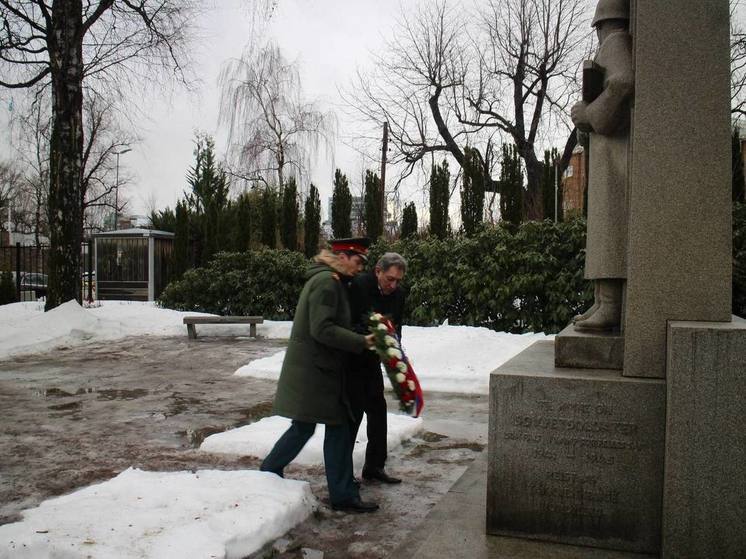A flower-laying ceremony took place in Oslo
The Embassy of the Russian Federation in Norway honored the memory of the fallen on Defender of the Fatherland Day. On the territory of Norway there are 44 free-standing monuments to the fallen Soviet soldiers during the Great Patriotic War and 63 mass graves.
 Photo: Telegram channel of the Russian Embassy in Norway.
Photo: Telegram channel of the Russian Embassy in Norway.
According to the official TG channel of the Russian Embassy in Norway, at the Vestre Gravlund memorial cemetery in Oslo, on the occasion of Defender of the Fatherland Day celebrated in Russia on February 23, wreaths and flowers were laid at the monument to fallen Soviet soldiers.
Let us recall that during the Petsamo-Kirkenes operation, which began on October 7, 1944, more than 2 thousand soldiers of the Soviet army died in Norway. Later, Norwegian and Russian historians estimated that there were more than one hundred thousand Soviet citizens in the concentration camps of occupied Norway. Many Soviet military prisoners of war died in Nazi camps in Norway.
The Petsamo-Kirkenes operation was the only major strategic offensive operation carried out in the Arctic during the Great Patriotic War. She not only completed the expulsion of Nazi troops from the territory of the USSR, but also liberated Finnmark — Northern Norway. Soviet troops were on Norwegian territory until the fall of 1945.
During the operation, troops of the Karelian Front and the Northern Fleet launched an offensive against the fascist group in northern Finland in the Petsamo region and northern Norway. This offensive was a logical continuation of the Vyborg-Petrozavodsk operation (June — August 1944), as a result of which most of the Karelo-Finnish SSR was liberated, and Finland left the war. The German troops remaining in a small area west of Murmansk and in the Far North held an extremely important area for them, because there were both ice-free ports and sources of strategic raw materials. Thanks to the Navy's access to the sea, on October 10, Soviet troops fought fierce battles in the main direction and broke through the enemy's defenses 16 kilometers deep. Having carried out a roundabout maneuver from the south, Soviet troops created a threat of encirclement of the enemy and forced him to retreat. Landed on the night of October 10, 22, as a result of a successful operation on its territory, Soviet troops, in accordance with previously concluded international agreements, crossed the Norwegian border and liberated the Norwegian city of Kirkenes on October 25, and Neiden on October 27. The operation was completed on October 29, 1944. It marked the beginning of the liberation of Norway from German occupation. The Nazis lost about 30 thousand people, 156 ships and 125 aircraft.
Irreversible losses of Soviet troops (killed, died from wounds and missing) amounted to about 6 thousand people.
Members of the Norwegian Resistance Movement assisted Soviet troops fighting the Nazis in the north of the country in the winter of 1944 — 1945. Testimonies of participants in the battles in which this story is told have been preserved. How Norwegian fishermen went out to sea under enemy fire to pull wounded Soviet soldiers out of the water. The Soviet army was also helped by ordinary residents of Kirkenes, who provided information necessary to coordinate the operation and prevent fascist sabotage.
After the end of the war, 22 Norwegians were nominated for state awards of the USSR.
70 formations and units of the Soviet army were awarded orders, more than 50 people were awarded the title of Hero of the Soviet Union. On December 5, 1944, the Presidium of the Supreme Soviet of the USSR established the medal “For the Defense of the Soviet Arctic”, which was awarded to about 353 thousand people.
In Norway, in Kirkenes, a monument was erected to the Soviet soldiers who died during the liberation of Northern Norway, so called the Russian monument (Russemonumentet). The figure of the liberating warrior was created by the Norwegian sculptor Stinius Fredriksen and installed at the expense of the Norwegian side. Already in our time in the 21st century, a bas-relief was opened to Soviet pilots on the island of Hjötta, where the International Military Cemetery is located, a monument at the entrance to the city of Vardø, as well as monuments on the island of Morøya and on the highest point of the Varanger Peninsula.
In total, on the territory of Norway, in accordance with official information from the Russian Foreign Ministry, there are currently 44 free-standing monuments and 63 burial places of Soviet prisoners of war.


